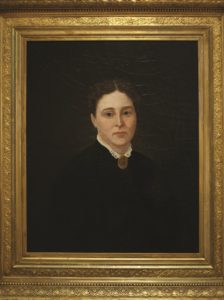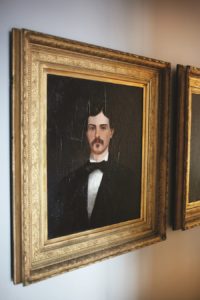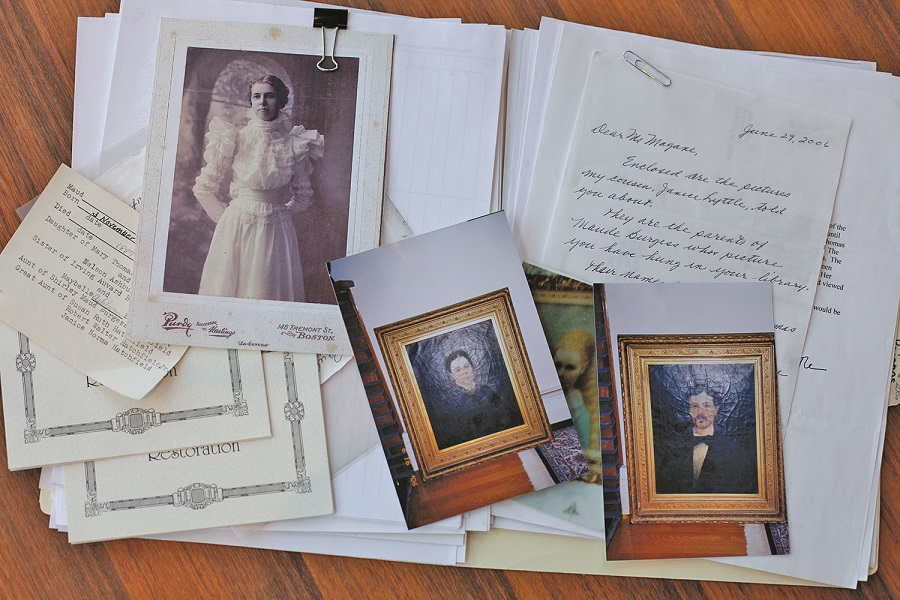The Eastham Room of the town’s library is brimming with archival records. But just outside the room hangs a trio of 19th-century portraits of residents whose lives were rich with history and intrigue.

The paintings, by an unknown artist or artists, depict Nelson Ashburn Burgess, Mary Thomas Higgins, and their daughter, Maud Burgess, who died of diphtheria at age 10. Mary Thomas Higgins was a descendant of Richard Higgins, an early settler of Eastham, but lived mainly in Boston. These are society pictures of upper-middle-class people — at least those who aspire to be.
The paintings were donated to the library in 2006 by cousins Jan Lyttle and Linda Beal, who are great-granddaughters of Nelson and Mary. The portrait of Maud was the first of the three paintings to find a home at the library. It had been lost and then found by the family.
“When I was growing up, we always had the portrait of Maud in our dining room,” says Lyttle, who lives in Avon. Her mother, Shirley Maud Burgess, was named after Maud, who would have been her aunt, and Shirley later inherited the painting from her father. “She was very touched when her father offered her this portrait,” says Lyttle. “It was something so special.”
In the soulful painting, Maud looks downward, her porcelain face surrounded by waves of golden hair. Everything about the girl is carefully styled, down to the folds of lace on her powder-blue dress. The artist seems to have imbued each stroke with love and care.

“My mother told me she was sick when she sat for the portrait,” recalls Lyttle. “I was always struck by her beauty.”
When it was time for the painting to be passed to the next generation, Lyttle’s sister was supposed to distribute her mother’s possessions, but instead she sold the painting.
“I was hysterical,” says Lyttle. “This was always supposed to be in the family.” She funneled her emotions into the task of finding the painting.
“I contacted the antique store on the Cape where it had been brought, and I heard it was sold,” says Lyttle. For six months, Lyttle put ads in local papers seeking its whereabouts. Eventually, another antique dealer contacted her, saying that he had bought the painting but then sold it to a woman in Virginia. After locating the bill of sale, he arranged for Lyttle to contact the owner, who agreed to sell the painting to her.
“We met at a Dunkin Donuts and made the transfer,” says Lyttle. “I paid a good bit of money and got back this family heirloom.”
After living with the portrait for three years, Lyttle decided to donate it to the Eastham library. “I was afraid if I passed away the people in my family might not think the portrait was important and it would end up in another antique shop,” says Lyttle. Given the family’s connection to Eastham, the library was grateful to have the portrait.

“We accept works that are exceptionally special and have historical or community value,” says Library Director Melanie McKenzie.
Not long after, Linda Beal donated the other two paintings. “My cousin had donated the painting of Maud, and she suggested the parents should go there,” says Beal.
Maud’s parents are pictured with elegant clothing and serious expressions, conveying a buttoned-up Boston reserve. The paintings follow conventions of the time: dark backgrounds, luminescent faces, highlights of white clothing and well-placed jewelry. They are influenced by both vernacular American portraiture and academic European painting.
The portrait of Nelson Ashburn Burgess is flatter than that of his wife, his face rendered with limited shading and modeling. It shows some relation to folk painting, though the artist clearly had one foot in the academic art world.
Mary Thomas Higgins’s face contrasts with the dark background, the slight tilt of her head articulating a nuanced line. The artist uses a range of soft peaches, pinks, and grays for her skin tone.

In addition to reflecting visual conventions of the time, these portraits also convey distinct personalities. Nelson Ashburn Burgess meets the viewer’s eyes directly, his erect posture displaying a straightforward confidence. Mary Thomas Higgins’s pose is more tentative, her eyes touched with sorrow.
Lyttle also donated a photocopy of a black-and-white photograph of the family that includes their other two children: Maybelle Burgess and Irving Burgess, who is the grandfather of Linda Beal and Jan Lyttle.
But Maud’s emotionally intriguing portrait is the centerpiece of the exhibit. Lyttle feels as though she has brought Maud home by donating the painting. “As much as possible,” she says, “families should stay together.”



